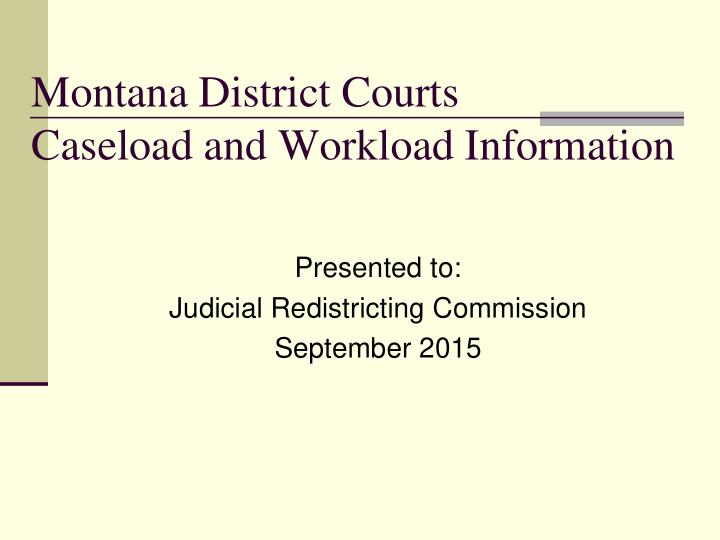



Montana District Courts Caseload and Workload Information Presented to: Judicial Redistricting Commission September 2015
Background Montana’s 56 District Courts Since 2001 Shared Funding: State appropriations cover the cost of judges, judges’ direct staff, youth court and certain court costs (witness, jury, travel, etc.) County appropriations cover the cost of courtroom and office space and the individual Clerk of the District Court offices in each county
Why HB435? Responsibility to manage taxpayer resources in an efficient manner Responsibility to equalize – to the degree possible – the workload Public policy decision about how the districts can best be configured Access (i.e. how long you have to wait for your day in court) is critical
District Court Financials 2016-17 biennial District Court budget - $57 million Personal services - 90% of the District Court budget Percentage of funding invested in personal services requires careful planning and management of resources
Historical Perspective: State assumption created the need for a consistent method for managing court files and counting cases across the District Court system and,: Meaningful caseload data to support an accurate analysis of workload and resource need in each of the state’s 22 Judicial Districts
How We Got Here Uniform Case Filing Standards Counting court cases the same in all counties Adoption of Minimum Staff Standards Consistency across all districts ( not in place ) Workload Study Assessing the workload – not just counting cases Developing Case Processing Measures Giving judges tools to manage the workload Equitably Distributing the Work Judicial Redistricting Study
13 Case Types Criminal Civil Adoptions Guardian & Conservator Juvenile Child Abuse and Neglect
13 Case Types Probate Domestic Relations Paternity Commitment, Developmental Disability Commitment, Mental Illness Investigative Subpoena Search Warrant (Treatment Court Cases*)
What Does this Mean for Workload? Other Work Caseload How many cases? How much travel? What type of cases? How many hours is a day? How long does it take to “judge” those How much non-judicial cases? time for training, staff supervision, community work?
How is the work Weighted Workload measured? Study The Gold Standard for • court case management A “judge year” is established studies allowing time for leave, Studies conducted and • education, staff supervision, etc. calculated by the National Center for State Judges recorded time worked for Courts in 2006 and 2014 8 weeks on a 15-minute basis Updated yearly with new • caseload and travel NCSC aggregated the time to information establish an average time per minute for each case type Travel was added based on reported time and actual mileage
Workload Study Spreadsheet Caseload and workload analysis Case weights by case type District by district judicial need Annual travel Analyze judicial need in single-judge districts versus multi-judge districts Timeliness and access Judicial substitution
Judicial Need by District (2014)
Judicial Need by District (2014)
What Drives the Growth Case Types Other Child Abuse and Probate Neglect Cases Search Warrants Criminal Cases Drug Treatment Courts Rebound in Civil Cases
Managing the Current Growth Steps taken Targeted impact Court Help Program Self-Represented Litigants Videoconferencing Reduce travel Drug Treatment Time-intensive but Dockets reduce repeat offenders Removing cases Standing master from judge
Considerations 2014 Judicial Need by County Without District Travel Factor
Additional Information 2015 case numbers and workload study by mid-January Travel information Additional caseload information Other information as requested
Recommend
More recommend